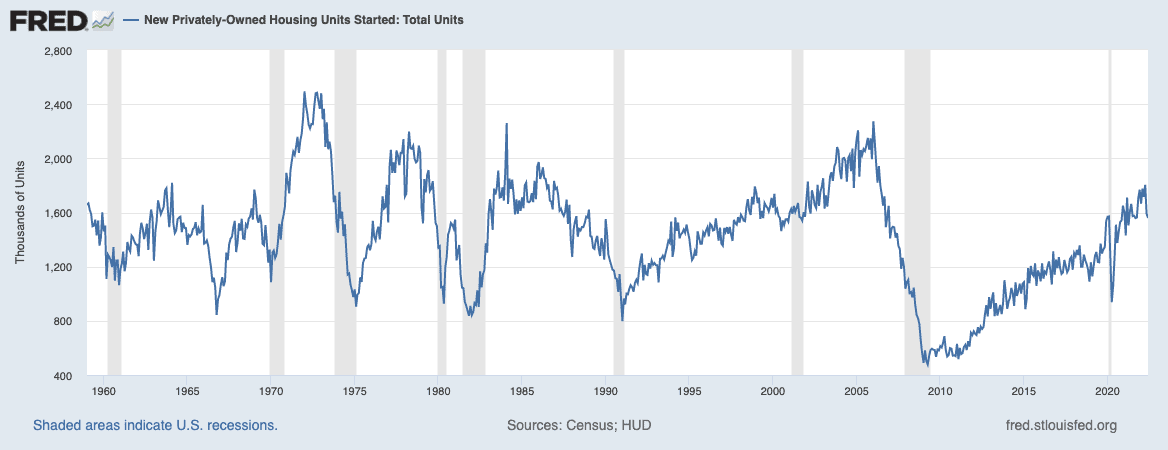Builders nationwide are warning real estate investors that new construction in the U.S. could be entering another phase of decline after showing continued growth since the end of the Great Recession. Privately owned housing starts had their slowest month since September 2021, dipping 2% month-by-month since May. According to the June U.S. Census Bureau Report, housing completions also slowed down in June, showing a 4.6% decline.

The most dramatic slowdown is being observed in the single-family sector. Here, the dip in housing start numbers is much more dramatic than the average—a significant 15.7% below June’s figures. Building permits were also down by 8%, which is the strongest indicator that future construction in this sector is in jeopardy.
Completion numbers are also lagging, with 1.68 million units started but not completed as of July. The construction industry is still reeling from months of labor and material shortages, with the supply of timber especially hard-hit. Slow completion rates and the many difficulties builders face, such as inflation and tightened and varied regulations across states, are creating a knock-on effect where future construction will also be subject to continued delays and shortages, but perhaps even worse than it’s been.
Multifamily Starts Showing Strength
Not all housing starts are falling uniformly. Currently, housing start figures are being evened out by the multi-family sector, the only sector where numbers are improving. Housing starts of five units and more leaped by 15% in June, up 16.4% year-over-year. Real estate investors should pay attention to this specific trend because it will likely continue into the foreseeable future.
There is a shortage in the multi-family rented housing start sector, though. With single-family rents rising steeply, the appeal of multi-family rented home construction is increasing, buoying up this construction segment. So, while overall buyer traffic is beginning to tick down thanks to record home prices and rising interest rates, multi-family building is on the up, offering buyers a highly sought-out alternative to unsustainable rent levels.
This is highly likely to become a longer-term trend for families seeking affordable housing options nationwide. Remember: the pandemic has made vast swathes of the population more mobile and has created an appetite for moving to areas with more affordable housing. The multi-family housing start model is a model for the future and will only become more in-demand with time.
Will the significant pull-back from the single-family sector cause a nationwide housing market decline? In a word, no. Firstly, it’s important to factor in regional variations. The decline in single-family new construction and permits is uneven geographically. The Midwest is actually experiencing an increase in single-family housing starts, while other regions, notably the Southwest, are declining.
This suggests that the single-family segment is volatile but that the downward trajectory is not uniform and is likely to be impacted more by regional socio-economic factors than by a systemic decline. Investors will need to pay close attention to regional differences and what they mean for future investment prospects in the single-family segment.
The other important thing to remember is that even with a steady decline in housing starts and building permits, home prices will not crash. In many ways, the “new normal” housing market conditions of the pandemic have skewed perceptions of what housing market growth ordinarily looks like.
The near-20% home price increases we’ve been seeing during the last two pandemic years were never here to stay. The 7-8% growth levels we see now are closer to pre-pandemic market conditions, which were still auspicious. Even with a decline in home price growth, home prices are still rising, so they won’t dip below profitable levels any time soon.
Note to Investors
Every investor should bear in mind the continuing shortages in the housing sector. This shortage will not ease any time soon; in fact, we’ve been short for over a decade. It’s not going to suddenly change this summer, which means that the housing market will remain stable and home prices will remain elevated.
Find an Agent in Minutes
Match with an investor-friendly real estate agent who can help you find, analyze, and close your next deal.
- Streamline your search.
- Tap into a trusted network.
- Leverage market and strategy expertise.

Note By BiggerPockets: These are opinions written by the author and do not necessarily represent the opinions of BiggerPockets.
